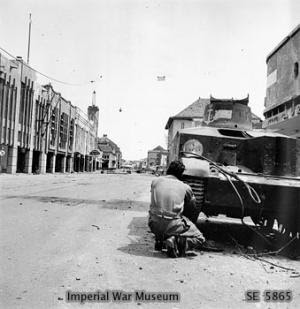Battle of Surabaya was the historical incident of war between the Indonesian army and Dutch troops. This great event occurred on November 10, 1945 in Surabaya, East Java. This battle was the first war of Indonesian forces with foreign troops after the Proclamation of Independence of Indonesia and one of the largest and heaviest battles in the history of the Indonesian National Revolution who became a national symbol of Indonesian resistance against colonialism.
Chronology of incident causes
The death of Brigadier General Mallaby
After the ceasefire between the Indonesian and British soldiers signed on October 29, 1945, the state gradually subsided. Although it still occurs armed clashes between the people and the British troops in Surabaya. Armed clashes in Surabaya that culminated with the murder of Brigadier General Mallaby, (led British troops to East Java), on October 30, 1945 approximately at 20:30. Buick carrying Brigadier General Mallaby Indonesia passed a group of militia when going through the Red Bridge. Misunderstanding leads to a shootout that ended with the death of Brigadier General Mallaby by a pistol shot a young Indonesian man who until now could not be identified, and the burning car hit by a grenade explosion that causes the body Mallaby difficult to identify. Mallaby death caused the British angry with the Indonesian side and resulted in the replacement decision Mallaby, Maj. Gen. Eric Robert Carden Mansergh issued an ultimatum to 10 November 1945 to ask the Indonesian side handed weapons and stop fighting the army and administration AFNEI NICA.
Ultimatum 10 November 1945
After the murder of Brigadier General Mallaby, his successor, Maj. Gen. Robert Mansergh issued an ultimatum stating that all the leaders and people of Indonesia are armed to report and put the gun in the place designated and submit himself to raise their hands above. Limit of the ultimatum was at 6:00 am on 10 November 1945.
The ultimatum was later regarded as an insult to the fighters and the people who have shaped many agencies struggle / militia. The ultimatum was rejected by the Indonesian side of the Republic of Indonesia on the grounds that it was already standing, and the People's Security Army (TKR) has also been established as the state troops. In addition, many organizations have formed an armed struggle of society, including among young people, students and students who oppose the entry of a ride back to the Dutch presence of British troops in Indonesia.
On 10 November morning, British troops launched a large-scale attack, which begins with aerial bombing government buildings to Surabaya, and then deploy about 30,000 infantry, a number of aircraft, tanks, and warships.
England then bombarded the city of Surabaya with a cannon from the sea and land. Resistance forces and militia Indonesia then raged throughout the city, with the active assistance of the population. Involvement of residents in this battle resulted in thousands of civilians falling victim in the attack, both dead and wounded.
Bung Tomo in Surabaya, one of the leaders of Indonesia's most revered revolutionary. This famous photograph for many people involved in the Indonesian National Revolution represents the soul of the major revolutionary struggle Indonesia at that time. [5]
To her surprise the British who suspect that the resistance in Surabaya can be conquered in three days, the community leaders such as Bung Tomo young pioneers who have a big impact in the community continues to drive the spirit of resistance Surabaya youth so that resistance persists in the midst of large-scale attack England.
Religious leaders of the clergy as well as Java kyais cottage like KH. Hashim Ash'ari, KH. Wahab Hasbullah and other boarding kyais also exert their students-students and civil society as a militia resistance (at the time people are not so obedient to the government but they are more submissive and obedient to the religious scholars) shingga Indonesia longstanding opposition party, from day to day, from week to week to another. Resistance of the people who initially made spontaneously and not coordinated, more and more regularly. This large-scale battle to achieve up to three weeks, before the entire city of Surabaya finally fell in the hands of the British.
At least 6.000 to 16.000 of the Indonesian fighters were killed and 200,000 civilians fled from Surabaya. [2]. Victims of British and Indian troops about a number of 600 - 2000 soldiers. [3] in the bloody Battle of Surabaya which took thousands of lives that have moved the people's resistance throughout Indonesia to repel the invaders and defend freedom. The number of fighters who are killed and civilians who were victims on the day of 10 November was later remembered as Heroes Day by Republic of Indonesia until now.

